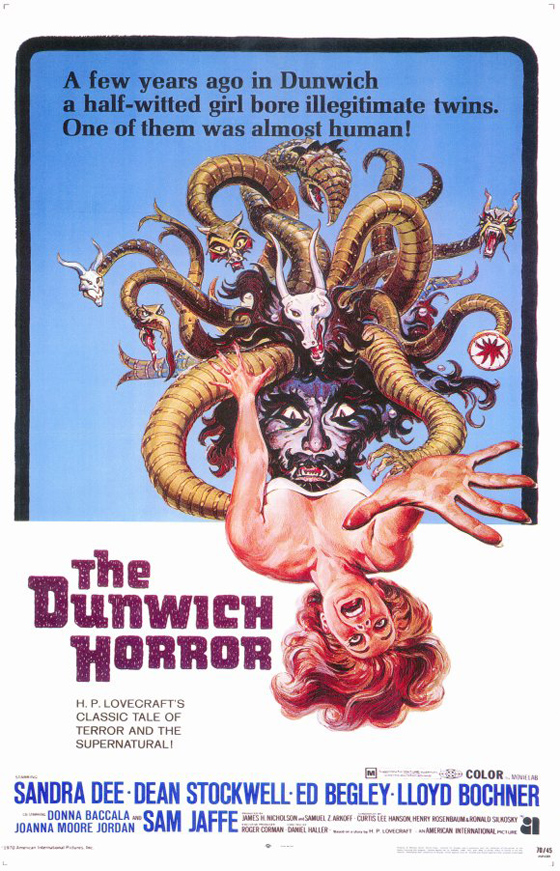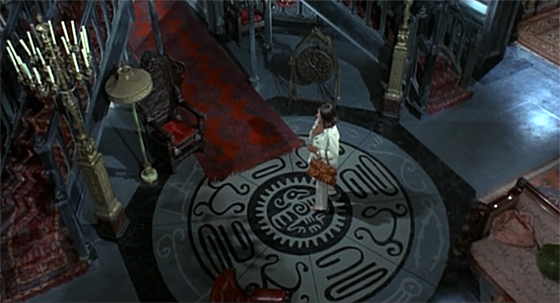
The Dunwich Horror (1970) ought to have been the launch of a new series at American International Pictures, one along the lines of the Roger Corman/Vincent Price/Edgar Allan Poe films of the 60’s, but this cycle delving into H.P. Lovecraft’s world of “cosmic horror.” AIP had taken some steps in the direction of Lovecraft already. One of those “Poe” films was actually a Lovecraft adaptation – though The Haunted Palace (1963) borrowed its title from Poe, it was based on Lovecraft’s novella The Case of Charles Dexter Ward. The director of The Dunwich Horror, Daniel Haller, had previously made Die, Monster, Die! (1965) with Boris Karloff, based loosely on Lovecraft’s “The Colour Out of Space.” But The Dunwich Horror nonetheless represented something different. The Corman-produced film, with a screenplay co-written by Curtis Hanson (L.A. Confidential), doesn’t mask its roots. Here you will find the Necronomicon on display in a glass case, and the names of Yog-Sothoth and “The Old Ones” invoked frequently. It feels more akin to Stuart Gordon’s adaptations: reverent, and the work of a fan. Though the Cthulhu Mythos was well-known in certain circles in 1970, it was nowhere near the pop culture phenomenon that it is today (step into any bookstore and Lovecraft is a major presence down the SF/Fantasy aisles). Sadly, The Dunwich Horror proved to be a false start. AIP moved onto blaxploitation and Doug McClure movies, and it would be left to Rod Serling’s Night Gallery to bring us televised adaptations of his work, until Gordon and others finally revived his world on the big screen. Dunwich was unfortunately just a one-off.
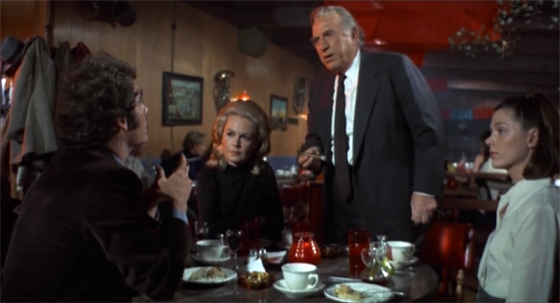
Wilbur Whateley (Dean Stockwell) explains his interest in the Necronomicon to Dr. Armitage (Ed Begley) before students Nancy (Sandra Dee) and Elizabeth (Donna Baccala).
Dean Stockwell, last seen on the big screen in Psych-Out (1968) with Jack Nicholson, plays Wilbur Whateley, a considerably more attractive specimen than the Wilbur of Lovecraft’s original (“almost eight feet tall…a dark and goatish gargoyle”). He arrives at Arkham’s Miskatonic University Library to study one of the rare copies of the Necronomicon, to the objection of Dr. Henry Armitage (Ed Begley, in one of his last roles – he died the same year). But Whateley and his mesmeric eyes have a strange effect on the blonde, virginal Nancy Wagner (top-billed Sandra Dee of Gidget fame). After he misses the last bus to Dunwich, she gives him a ride home and winds up staying the night in the Whateley House, which is riddled with occult objects, candelabras, and purple light. There he lives alone with his mad grandfather (Sam Jaffe, The Day the Earth Stood Still), though one mysterious door has a tendency to rattle its lock during the night. Nancy has dreams of being chased by nude cultists covered in body-paint. In the morning, Whateley takes her out to “The Devil’s Hop-Yard,” an ancient altar surrounded by grotesque statues and perched at the edge of a cliff overlooking the sea. She lies upon the altar with little persuading, and has visions of human sacrifice.
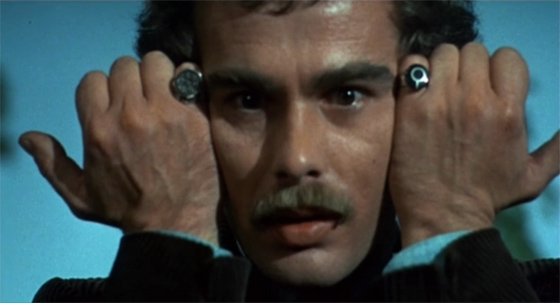
Stockwell chants "Yog-Sothoth."
Meanwhile, her friends grow concerned over her absence. It seems Whateley’s family has a horrific history: his great-grandfather was hanged for occult practices, and after a traumatic birth – Wilbur had a twin brother who is said to have died stillborn, though no one saw the body – his violent, raving mother was committed to an asylum; nobody knows who the father was. When Nancy’s friend Elizabeth (Donna Baccala) explores the Whateley House alone, she finds the locked, rattling door, and opens it, encountering a bizarre monster that attacks and devours her. The increasingly unhinged Wilbur pushes his grandfather down the stairs, then tries to give him a burial in the Dunwich Cemetery before the locals object to his non-Christian rites. Eventually he leads Nancy back to the Devil’s Hop-Yard to sacrifice her and to deliver Yog-Sothoth into this dimension from another, while a monster – his twin brother, bearing a closer resemblance to their father than Wilbur does – rampages through the woods and farms of Dunwich. Professor Armitage enlists the local doctor, Cory (Lloyd Bochner, Point Blank), to help him track down Whateley and rescue Nancy – and the human race.
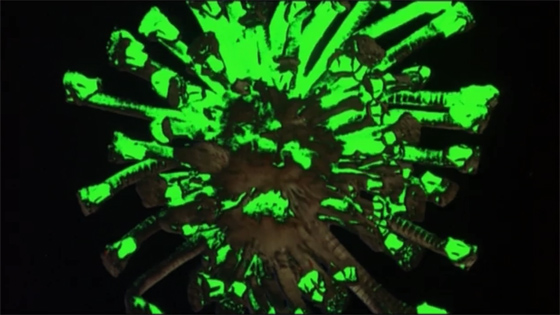
"The Dunwich Horror," an example of the film's psychedelic special effects.
As a horror film and an entertainment, it has its faults. The film grows sluggish and Les Baxter’s score becomes more repetitive as the film wears on; when the “Dunwich Horror” is finally unleashed – what should give the story its second wind – lackluster special effects destroy any suspense. Whenever the monster is present, we’re simply treated to basic optical tricks: negative-images and psychedelic colors. The Horror itself is clearly not much better than those from the last ten minutes of various 50’s science fiction movies (The Beast with 1,000,000 Eyes, etc.); and here is one case where we can be thankful the poster shows the monster, so we can get a better idea of what they were going for. These caveats aside, The Dunwich Horror does manage to capture the nightmare-logic of Lovecraft, and has a genuinely dream-like feel, much like those earlier Corman/Poe movies. Stockwell, with his monotone and hypnotic eyes (he widens them every few sentences or two, as if to keep the listener held tight within his tractor-beam), is particularly good. There are some bows to the times; a Rosemary’s Baby influence is evident (particularly in the needless final shot), and there’s some fleeting nudity – when Whateley’s monstrous twin devours poor Elizabeth, he somehow manages to strip her naked at the same time, though given the flashing colors it’s a bit more discreet than in Corman’s later Galaxy of Terror (1981). I’d have liked to have seen more AIP takes on this Lovecraftian subject matter, but, as in so much of the master’s fiction, we’ll have to use our imagination.
